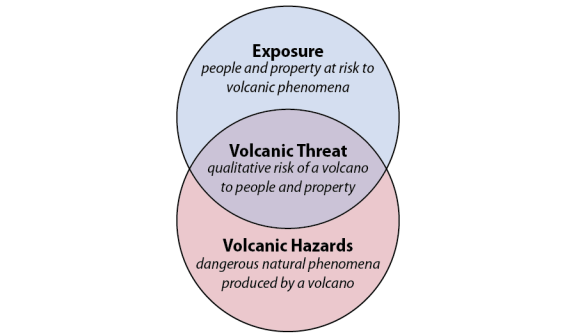
Source: USGS.
In the 115th Congress, two bills authorizing a National Volcano Early Warning and Monitoring System (NVEWS) have been reported out of committee (H.R. 4475, reported out of the House Natural Resources Committee and S. 346, reported out of the Senate Energy and Natural Resources Committee). Legislation nearly identical to S. 346 is included as Title X, Subtitle A, of S. 1460, the Energy and Natural Resources Act of 2017. (A hearing has been held on this bill.) The activities authorized in these bills include directing the U.S. Geological Survey (USGS) to establish a nationwide volcano early warning and monitoring system to lower the impacts of volcanic eruptions on U.S. citizens. USGS is a bureau within the Department of the Interior.
USGS has indicated that progressively implementing an NVEWS to address a monitoring gap within its Volcano Hazards Program has been a priority since 2005. These bills would provide an explicit authorization for an NVEWS, with an objective to monitor U.S. volcanoes at a level commensurate with the volcanic threat. Assessing the volcanic threat involves combining the volcano hazards—the destructive phenomena produced by a volcano, such as lava flows, ash clouds, volcanic landslides—and the exposure to the hazard, such as the people and property at risk from a volcanic eruption (Figure 1).
The bills state that the NVEWS would have two purposes: (1) to organize, modernize, standardize, and stabilize the monitoring systems of the five U.S. volcano observatories (the Alaska Volcano Observatory, California Volcano Observatory, Cascades Volcano Observatory, Hawaiian Volcano Observatory, and Yellowstone Volcano Observatory) and (2) to unify the monitoring systems of these observatories into a single interoperative system.
 |
|
Source: USGS. |
The bills would authorize three system components: (1) a 24-hour, 7-days-a-week operational national volcano watch office, (2) a national volcano data center, and (3) an external grants program to support volcano research. The legislation also would establish an advisory committee to the program composed of federal agency and scientific community representatives and would allow for cooperative agreements with academic institutions and state agencies to designate them as volcano observatory partners for the NVEWS. In addition, the bills would require a five-year management plan for the system, due within 180 days of enactment.
The bills would authorize USGS to modernize the monitoring system at the volcano observatories within the NVEWS to incorporate emerging technologies, such as digital broadband seismometers, real-time Global Positioning System Receivers, satellite and airborne radar interferometry, acoustic pressure sensors, and spectrometry to measure gas emissions from volcanoes. These technologies would provide more accurate and real-time or near-real-time measurements, enabling better assessments of the timing and location of volcanic eruption threats. These improvements likely would provide better forecasts of aviation hazards and allow emergency managers to improve evacuation alerts and better position resources to prepare for imminent eruptions.
H.R. 4475 would require a feasibility study to determine if volcano observatories should be established in U.S. territories, including Guam, Northern Mariana Islands, and American Samoa, to monitor the western and southern Pacific Ocean volcanoes (along the so-called Ring of Fire). Also, H.R. 4475 would include territorial agencies as eligible volcano observatory partners under cooperative agreements. S. 346 (and S. 1460) does not address territories as possible locations for additional volcano observatories and limits partnerships under cooperative agreements to state agencies.
H.R. 4475 would authorize appropriations of $15 million annually for FY2018 through FY2024 for the NVEWS; S. 346 (and S. 1460) would authorize such sums as necessary for NVEWS through FY2027.
The USGS published a framework study for an NVEWS in 2005 that identified 58 priority volcanoes that were under-monitored for volcanic threats. Improvements since then have brought the current list to 55 priority volcanoes (Table 1). The program authorized by H.R. 4475 and S. 346 could build off that study to identify which volcanoes need new or updated monitoring networks to address threats. Hawaiian volcano Kilauea, whose most recent eruptions have been accompanied by destructive lava flows, is listed in the table as highest priority for monitoring. Kilauea is the youngest and southeastern-most volcano on the island of Hawaii, and its recent eruptions have been accompanied by frequent earthquakes, including one of magnitude 6.9.
|
Region |
Highest Priority |
High Priority |
|
|
Alaska |
Akutan, Amak, Amukta, Augustine, Bogoslof, Cleveland, Fourpeaked, Kasatochi, Kiska, Makushin, Recheshnoi, Redoubt, Seguam, Vsevidof, Yantarni, Yunaska |
Black Peak, Chiginagak, Churchill, Dana, Douglas, Dutton, Edgecumbe, Hayes, Kaguyak, Kupreanof, Spurr, Wrangell |
|
|
Washington |
Glacier Peak, Baker, Ranier, St. Helens |
Adams |
|
|
Oregon |
Crater Lake, Hood, Newberry, Three Sisters |
None listed |
|
|
California |
Lassen Volcanic Center, Shasta |
Clear Lake, Mono-Inyo Craters, Mono Lake Volcanic Field, Medicine Lake |
|
|
Wyoming |
None listed |
Yellowstone |
|
|
Hawaii |
Kilauea, Mauna Loa |
Hualalai |
|
|
Commonwealth of North Mariana Islands |
Agrigan, Alamagan, Anatahan, Asuncion, Farallon de Pajaros, Guguan, Pagan |
Sarigan |
Source: USGS.
Note: 35 volcanoes or regions currently ranked as highest priority, 20 are currently ranked as high priority. Some regions contain more than one volcano.
In its FY2018 budget justification, the Administration proposed suspending implementation of current NVEWS activities within USGS and reducing funding for the Volcano Hazards Program by about $3.6 million (from a total of about $28 million in FY2017). Congress instead chose to increase funding for the program to $42.6 million in FY2018.
In its FY2019 budget justification, the Administration again proposed to reduce funding for the Volcano Hazards Program compared to the prior year (the FY2019 request is for $22.3 million), and it proposed a specific $1.5 million reduction to the NVEWS program activities at USGS.